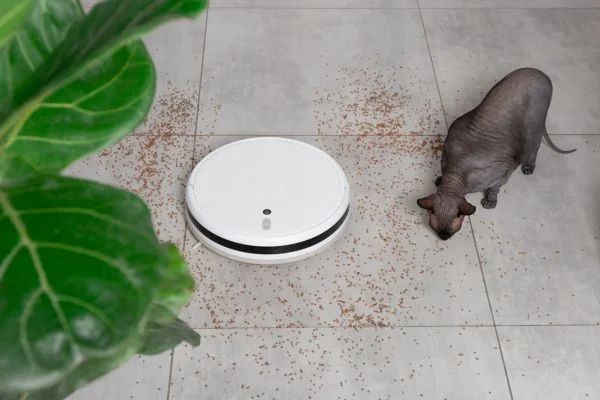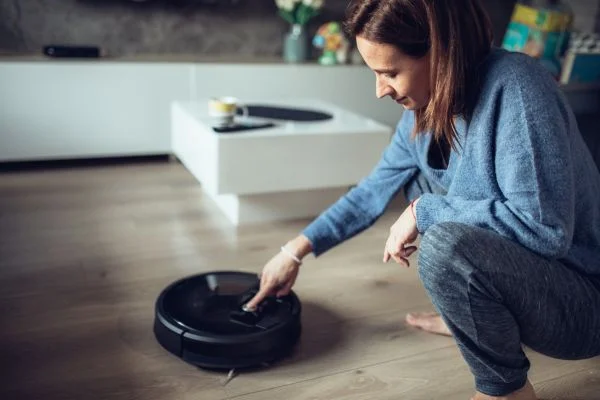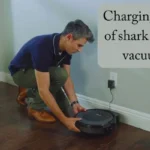Want to know how often to run robot vacuum? The frequency of running a robot vacuum depends on factors like pet shedding, children, environmental conditions, and family members’ health. For shedding pets and active households, daily or every other day, vacuuming is recommended, while homes with allergies may require more frequent cleaning.
How Often Should I Run My Robot Vacuum?
How often you should run your robot vacuum depends on various factors, including the presence of shedding pets, the number of children, and the overall environmental conditions in your home. You should know how often to run robot vacuum. For households with shedding pets or multiple children, daily or every other day vacuuming is recommended.
With Shedding Pets:

If you have shedding pets at home, such as dogs or cats, running your robot vacuum more frequently is essential to keep up with the constant fur accumulation. Pets with thick fur tend to shed year-round, and their hair can quickly spread all over the house.
To maintain a clean environment and reduce the risk of allergens, running the robot vacuum daily or every other day is recommended. This regular schedule will help prevent excessive fur buildup and ensure a more comfortable living space for both your family and your furry friends.
With Children:
Families with children often face higher levels of daily messes, including crumbs, spills, and dirt dragged in from outdoor activities. A robot vacuum can be a valuable tool for maintaining a clean floor in such households.
For busy families, running the robot vacuum at least once a day, preferably after mealtimes or play sessions, can help keep the floor tidy and reduce potential health hazards. Additionally, frequent vacuuming can prevent small objects or toys from getting caught in the vacuum and causing damage.
Other Environmental Concerns:
Factors like location, climate, and proximity to natural elements can impact how often you should run your robot vacuum. For example, if you live in an area with high pollen counts or near a construction site, your floors may accumulate more dust and debris.
In such cases, running the robot vacuum every day or every other day can help maintain a healthier indoor environment. Similarly, homes in dusty regions may benefit from more frequent vacuuming to prevent the buildup of allergens and respiratory irritants.
Consider Your Family Member’s Health:
In households with family members who have allergies or respiratory issues, running the robot vacuum frequently becomes even more crucial. Allergens like dust mites, pollen, and pet dander can accumulate rapidly, triggering allergic reactions and respiratory discomfort.
To mitigate these health risks, it is advisable to run the robot vacuum daily or as recommended by a healthcare professional. Regular vacuuming can significantly reduce allergen levels, providing a healthier living space for everyone.
Read more about
Read more about How Long to Charge Shark Robot Vacuum?
Factors Affecting Vacuuming Frequency:
Pet Type and Coat Length:
The type of pet you have and the length of their coat directly influence how much they shed and how often you should run the robot vacuum.
Long-haired breeds shed more and require more frequent vacuuming, while short-haired pets might not demand daily cleaning. Assess your pet’s shedding pattern and adjust the vacuuming schedule accordingly.
Number of Children and Activities:

Homes with more children tend to witness increased foot traffic and a higher likelihood of spills and messes. The more active your household is, the more frequently you may need to run the robot vacuum to keep up with the constant influx of dirt and debris.
Indoor vs. Outdoor Activities:
If your family spends a lot of time outdoors, you’ll likely bring in more dirt and contaminants from outside. This can impact your indoor air quality and hygiene, making it necessary to run the robot vacuum regularly to maintain a clean environment.
Seasonal Factors:
Seasonal changes, like shedding during spring or more time spent indoors during winter, can affect the frequency of vacuuming. Adjust your robot vacuum’s schedule to accommodate these seasonal variations in dirt and debris accumulation.
Vacuuming Technology and Capacity:
The capabilities of your robot vacuum, such as suction power and dirt capacity, can also influence how often you should run it. Higher suction power allows for better cleaning, while larger dirt bins reduce the need for frequent emptying during vacuuming sessions. Now you know how often to run robot vacuum.
Read more about What Robot Vacuum is Good for High Pile Carpets?
Robot Vacuum and Mop Maintenance Tips
By following these maintenance tips, you can ensure that your robot vacuum and mop perform optimally, providing you with clean floors and a hassle-free cleaning experience.
Clear Cords and Curtains:
Before starting your robot vacuum, ensure that the cleaning area is free from potential obstacles that might impede its performance.
Remove any loose cords, cables, or wires lying on the floor as they can get tangled in the vacuum’s brushes or wheels. Curtains or drapes that hang low should also be lifted or secured to prevent them from being caught or damaged during the cleaning process.
Do a Test Run:
If you’re using your robot vacuum for the first time or have made significant changes to its settings, it’s a good idea to do a test run. This allows you to observe how the vacuum navigates through your home, whether it avoids obstacles effectively, and if it reaches all the desired cleaning areas.
Running a test cycle also helps identify potential issues early on, so you can address them before regular use.
Empty the Dustbin and Refill the Water Tank:
For robot vacuums equipped with a dustbin or water tank, it’s crucial to empty and clean them regularly. After each cleaning session, remove the dustbin, empty its contents into a trash bag, and rinse it if necessary.
If your robot has a mop function, ensure the water tank is refilled with clean water before each use. Keeping these components clean ensures optimal performance and prevents unpleasant odors.
Check and Clean Brushes and Filters:
Robot vacuums have various brushes and filters that require regular maintenance. Check the manufacturer’s guidelines to know how often these components should be cleaned or replaced.
Remove tangled hair, debris, and dust from the brushes, and rinse or replace the filters as needed. Keeping these parts clean ensures efficient cleaning and prolongs the life of your robot vacuum.
Read more about How To Clean Smelly Carpet At Home?
Inspect Wheels and Sensors:
Regularly inspect the wheels of your robot vacuum for any debris, hair, or threads that might be stuck. Clean the wheels and ensure they can move freely without any hindrance.
Additionally, check the sensors on your robot to ensure they are clean and unobstructed. Sensors play a crucial role in the vacuum’s navigation and obstacle detection, so keeping them clean is vital for optimal performance.
Clean the Charging Contacts:
The charging contacts on your robot vacuum can gather dust and dirt over time, affecting the charging efficiency.
To ensure your robot charges properly, inspect the charging contacts regularly and clean them with a soft, dry cloth. This simple maintenance step helps your robot stay charged and ready for the next cleaning session.
Regularly Clean the Mop Cloth:
For robot vacuums with mopping functionality, it’s essential to clean the mop cloth or pad after each use. Rinse it thoroughly under running water and allow it to air dry before storing it.
Some robot vacuums come with machine-washable mop pads, making maintenance even more convenient. Clean mop cloths ensure your floors are effectively mopped without spreading dirt around.
Check for Software Updates:

Manufacturers often release software updates for robot vacuums to improve their performance, navigation, and features.
Check the manufacturer’s website or the robot vacuum’s app for any available updates and ensure your device is running the latest software version. Updated software can enhance your robot’s performance and fix potential bugs or issues.
Store the Robot Properly:
When not in use, store your robot vacuum in a clean and dry area. Keep it away from direct sunlight or extreme temperatures. Use the charging dock to store the robot, ensuring it’s always ready for the next cleaning session. Proper storage prolongs the life of your robot vacuum and keeps it in good working condition.
FAQs about how often to run robot vacuum
What is the best time of day to run a robot vacuum?
The best time to run a robot vacuum is when you’re not at home or during quieter hours, such as when everyone is asleep. This ensures the vacuum can work undisturbed and efficiently clean your floors without interfering with your daily activities.
Do robot vacuums use a lot of electricity?
Robot vacuums are designed to be energy-efficient. While they consume electricity during operation, their smart navigation and scheduled cleaning reduce overall energy consumption. Compared to traditional vacuums, robot vacuums use relatively less electricity, making them a cost-effective cleaning solution.
Should I leave the robot vacuum plugged in?
It’s generally safe to leave your robot vacuum plugged in when not in use. Most robot vacuums come with smart charging technology, and they stop charging once the battery is full. However, if you plan to store the vacuum for an extended period, you can unplug it to save energy.
Final Words
Maintaining a robot vacuum and mop is essential for optimal performance and longevity. Set a cleaning schedule that suits your household’s needs, clear cords and curtains to prevent obstacles, and perform a test run to ensure smooth operation. Regularly empty the dustbin and refill the water tank for mopping models. We hope now you know how often to run robot vacuum.
Clean brushes, filters, wheels, sensors, and charging contacts to keep the vacuum in top condition. Don’t forget to clean the mop cloth for mopping functionality. Check for software updates to improve performance. Store the robot vacuum in a clean, dry area when not in use.



